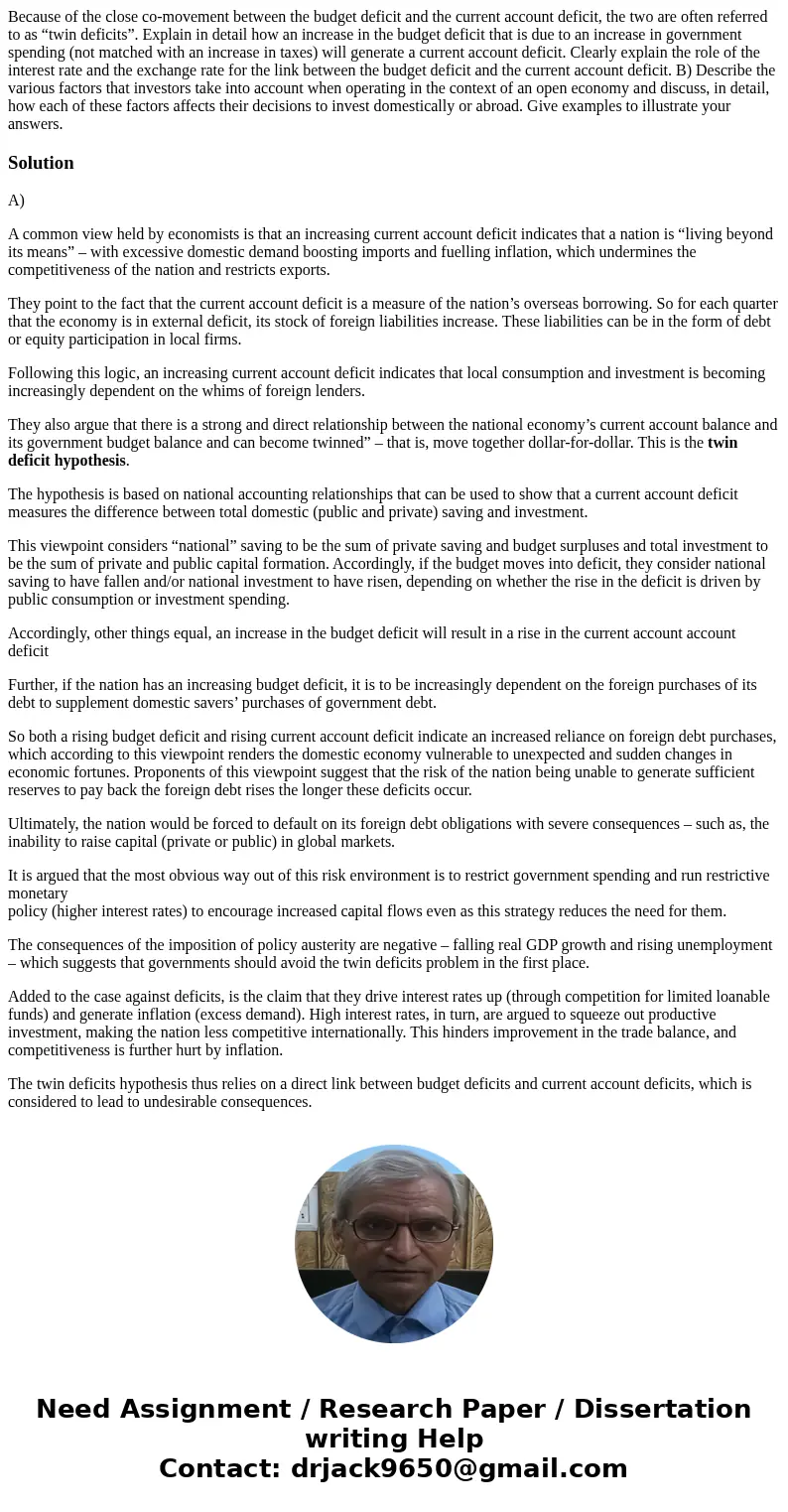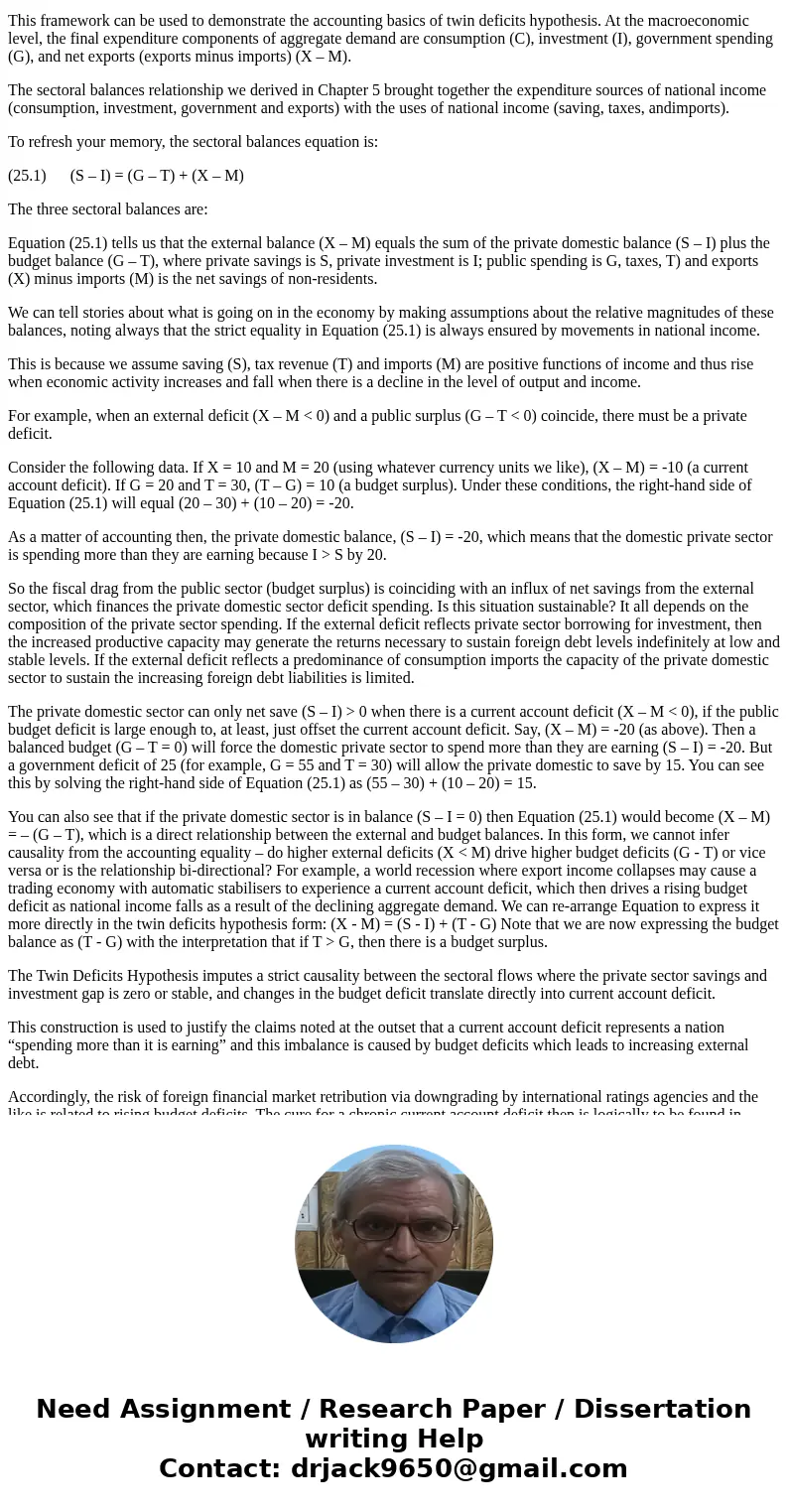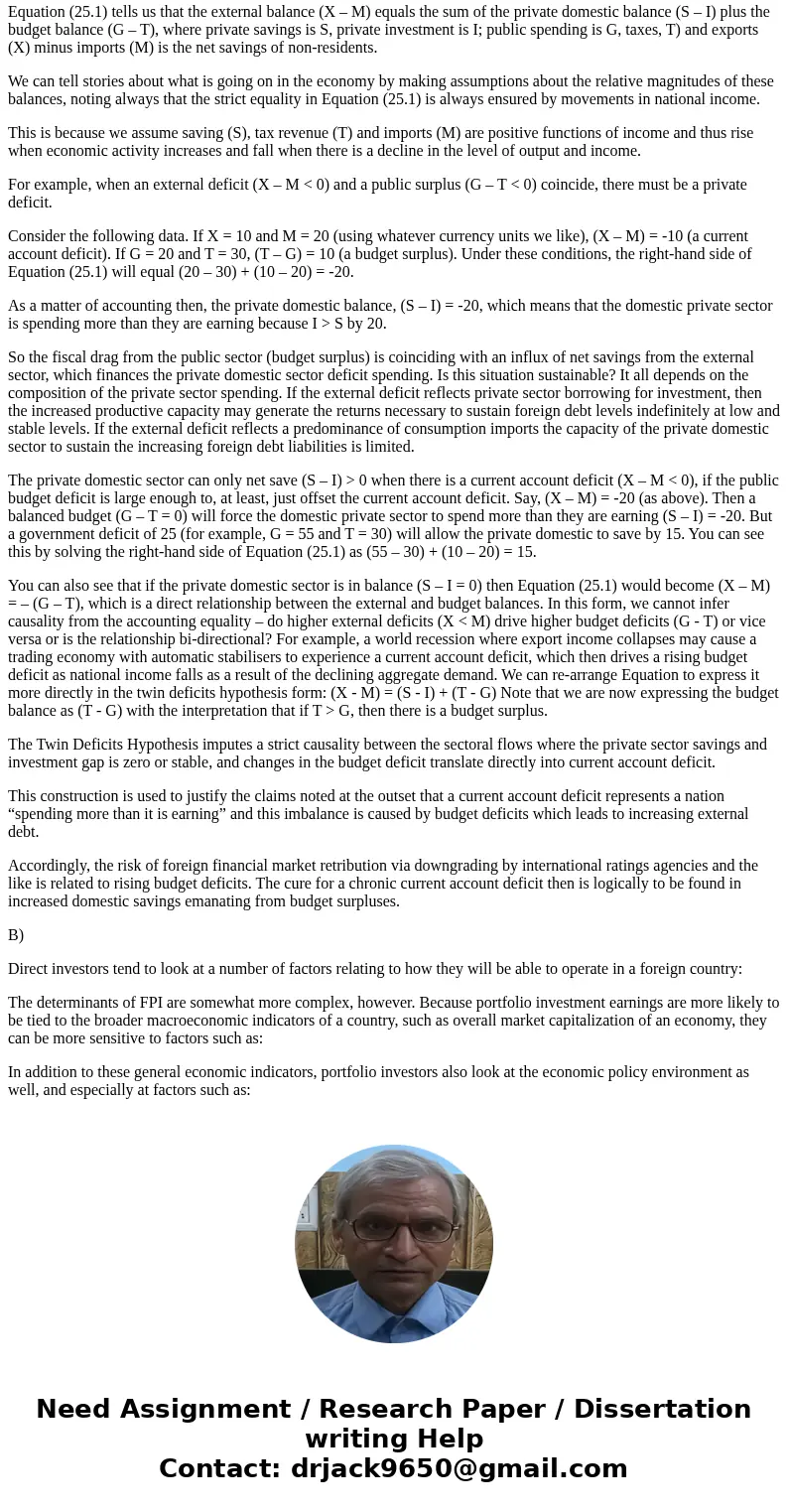Because of the close comovement between the budget deficit a
Because of the close co-movement between the budget deficit and the current account deficit, the two are often referred to as “twin deficits”. Explain in detail how an increase in the budget deficit that is due to an increase in government spending (not matched with an increase in taxes) will generate a current account deficit. Clearly explain the role of the interest rate and the exchange rate for the link between the budget deficit and the current account deficit. B) Describe the various factors that investors take into account when operating in the context of an open economy and discuss, in detail, how each of these factors affects their decisions to invest domestically or abroad. Give examples to illustrate your answers.
Solution
A)
A common view held by economists is that an increasing current account deficit indicates that a nation is “living beyond its means” – with excessive domestic demand boosting imports and fuelling inflation, which undermines the competitiveness of the nation and restricts exports.
They point to the fact that the current account deficit is a measure of the nation’s overseas borrowing. So for each quarter that the economy is in external deficit, its stock of foreign liabilities increase. These liabilities can be in the form of debt or equity participation in local firms.
Following this logic, an increasing current account deficit indicates that local consumption and investment is becoming increasingly dependent on the whims of foreign lenders.
They also argue that there is a strong and direct relationship between the national economy’s current account balance and its government budget balance and can become twinned” – that is, move together dollar-for-dollar. This is the twin deficit hypothesis.
The hypothesis is based on national accounting relationships that can be used to show that a current account deficit measures the difference between total domestic (public and private) saving and investment.
This viewpoint considers “national” saving to be the sum of private saving and budget surpluses and total investment to be the sum of private and public capital formation. Accordingly, if the budget moves into deficit, they consider national saving to have fallen and/or national investment to have risen, depending on whether the rise in the deficit is driven by public consumption or investment spending.
Accordingly, other things equal, an increase in the budget deficit will result in a rise in the current account account deficit
Further, if the nation has an increasing budget deficit, it is to be increasingly dependent on the foreign purchases of its debt to supplement domestic savers’ purchases of government debt.
So both a rising budget deficit and rising current account deficit indicate an increased reliance on foreign debt purchases, which according to this viewpoint renders the domestic economy vulnerable to unexpected and sudden changes in economic fortunes. Proponents of this viewpoint suggest that the risk of the nation being unable to generate sufficient reserves to pay back the foreign debt rises the longer these deficits occur.
Ultimately, the nation would be forced to default on its foreign debt obligations with severe consequences – such as, the inability to raise capital (private or public) in global markets.
It is argued that the most obvious way out of this risk environment is to restrict government spending and run restrictive monetary
policy (higher interest rates) to encourage increased capital flows even as this strategy reduces the need for them.
The consequences of the imposition of policy austerity are negative – falling real GDP growth and rising unemployment – which suggests that governments should avoid the twin deficits problem in the first place.
Added to the case against deficits, is the claim that they drive interest rates up (through competition for limited loanable funds) and generate inflation (excess demand). High interest rates, in turn, are argued to squeeze out productive investment, making the nation less competitive internationally. This hinders improvement in the trade balance, and competitiveness is further hurt by inflation.
The twin deficits hypothesis thus relies on a direct link between budget deficits and current account deficits, which is considered to lead to undesirable consequences.
This framework can be used to demonstrate the accounting basics of twin deficits hypothesis. At the macroeconomic level, the final expenditure components of aggregate demand are consumption (C), investment (I), government spending (G), and net exports (exports minus imports) (X – M).
The sectoral balances relationship we derived in Chapter 5 brought together the expenditure sources of national income (consumption, investment, government and exports) with the uses of national income (saving, taxes, andimports).
To refresh your memory, the sectoral balances equation is:
(25.1) (S – I) = (G – T) + (X – M)
The three sectoral balances are:
Equation (25.1) tells us that the external balance (X – M) equals the sum of the private domestic balance (S – I) plus the budget balance (G – T), where private savings is S, private investment is I; public spending is G, taxes, T) and exports (X) minus imports (M) is the net savings of non-residents.
We can tell stories about what is going on in the economy by making assumptions about the relative magnitudes of these balances, noting always that the strict equality in Equation (25.1) is always ensured by movements in national income.
This is because we assume saving (S), tax revenue (T) and imports (M) are positive functions of income and thus rise when economic activity increases and fall when there is a decline in the level of output and income.
For example, when an external deficit (X – M < 0) and a public surplus (G – T < 0) coincide, there must be a private deficit.
Consider the following data. If X = 10 and M = 20 (using whatever currency units we like), (X – M) = -10 (a current account deficit). If G = 20 and T = 30, (T – G) = 10 (a budget surplus). Under these conditions, the right-hand side of Equation (25.1) will equal (20 – 30) + (10 – 20) = -20.
As a matter of accounting then, the private domestic balance, (S – I) = -20, which means that the domestic private sector is spending more than they are earning because I > S by 20.
So the fiscal drag from the public sector (budget surplus) is coinciding with an influx of net savings from the external sector, which finances the private domestic sector deficit spending. Is this situation sustainable? It all depends on the composition of the private sector spending. If the external deficit reflects private sector borrowing for investment, then the increased productive capacity may generate the returns necessary to sustain foreign debt levels indefinitely at low and stable levels. If the external deficit reflects a predominance of consumption imports the capacity of the private domestic sector to sustain the increasing foreign debt liabilities is limited.
The private domestic sector can only net save (S – I) > 0 when there is a current account deficit (X – M < 0), if the public budget deficit is large enough to, at least, just offset the current account deficit. Say, (X – M) = -20 (as above). Then a balanced budget (G – T = 0) will force the domestic private sector to spend more than they are earning (S – I) = -20. But a government deficit of 25 (for example, G = 55 and T = 30) will allow the private domestic to save by 15. You can see this by solving the right-hand side of Equation (25.1) as (55 – 30) + (10 – 20) = 15.
You can also see that if the private domestic sector is in balance (S – I = 0) then Equation (25.1) would become (X – M) = – (G – T), which is a direct relationship between the external and budget balances. In this form, we cannot infer causality from the accounting equality – do higher external deficits (X < M) drive higher budget deficits (G - T) or vice versa or is the relationship bi-directional? For example, a world recession where export income collapses may cause a trading economy with automatic stabilisers to experience a current account deficit, which then drives a rising budget deficit as national income falls as a result of the declining aggregate demand. We can re-arrange Equation to express it more directly in the twin deficits hypothesis form: (X - M) = (S - I) + (T - G) Note that we are now expressing the budget balance as (T - G) with the interpretation that if T > G, then there is a budget surplus.
The Twin Deficits Hypothesis imputes a strict causality between the sectoral flows where the private sector savings and investment gap is zero or stable, and changes in the budget deficit translate directly into current account deficit.
This construction is used to justify the claims noted at the outset that a current account deficit represents a nation “spending more than it is earning” and this imbalance is caused by budget deficits which leads to increasing external debt.
Accordingly, the risk of foreign financial market retribution via downgrading by international ratings agencies and the like is related to rising budget deficits. The cure for a chronic current account deficit then is logically to be found in increased domestic savings emanating from budget surpluses.
B)
Direct investors tend to look at a number of factors relating to how they will be able to operate in a foreign country:
The determinants of FPI are somewhat more complex, however. Because portfolio investment earnings are more likely to be tied to the broader macroeconomic indicators of a country, such as overall market capitalization of an economy, they can be more sensitive to factors such as:
In addition to these general economic indicators, portfolio investors also look at the economic policy environment as well, and especially at factors such as:



 Homework Sourse
Homework Sourse